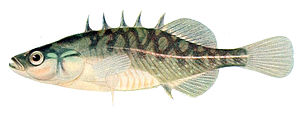North American speckled stickleback
| North American speckled stickleback | ||||||||||||
|---|---|---|---|---|---|---|---|---|---|---|---|---|

North American spotted stickleback ( Culaea inconstans ) |
||||||||||||
| Systematics | ||||||||||||
|
||||||||||||
| Scientific name of the genus | ||||||||||||
| Culaea | ||||||||||||
| Whitley , 1950 | ||||||||||||
| Scientific name of the species | ||||||||||||
| Culaea inconstans | ||||||||||||
| ( Kirtland , 1840) |
The North American stickleback ( Culaea inconstans ), also known as the five-pronged stickleback, is a fish and the only representative of the stickleback genus Culaea .
This species of stickleback is very similar to the nine-spined stickleback in many ways (behavior and appearance) . The first describer assigned the new species originally to the genus Gasterosteus , but later it was raised to the rank of a genus of its own. The new genus name Eucalia was already occupied by a butterfly genus and was replaced by the name Culaea, which is still valid today .
distribution and habitat
The North American speckled stickleback lives mainly in cool fresh water, for example spring waters. Its tolerance to temperature fluctuations and brackish or salty water is low. In summer, the habitat must have dense vegetation and soft ground to protect against predators. In winter, the speckled stickleback withdraws to deeper and lean layers of water (e.g. stream channels).
The distribution area is limited to North America.
features
With an average size of 6.5 centimeters, the speckled stickleback remains quite small. The four to six (usually five) dorsal spines are shorter than most other stickleback species. The ventral spines and the pelvic bones are also relatively poorly developed and may even be completely absent in some populations.
Outside of the breeding season, the silver stickleback wears a camouflage dress of olive green to brown in color. At spawning time, the males turn almost black. Your throat, chest and stomach take on a dark, green to brown color, the flanks have a fine turquoise or brass-colored dot pattern. The dorsal and anal fins darken, while the caudal fin turns white. A vertical black stripe runs through the iris. The females wear a brown spot pattern at spawning time.
The skin bears a number (30-36) of tiny bone platelets that extend from the rear edge of the gill cover to the base of the caudal fin. The small size of the platelets makes the skin appear bare.
Number of fin rays :
- Dorsal 1 V (IV – VI)
- Dorsal 2 10 (8–13)
- Anal I / 10 (7-12)
- Caudal 12 (11-12)
- Pectorals 10 (9-11)
behavior
The North American speckled stickleback feeds on small invertebrates, which it can bring out from deeper layers of mud. It is shy and, because of its weak defensive armament, uses similar protective behavior as the nine-spined stickleback in dangerous situations: fleeing animals seek cover from predators by boring themselves into the muddy ground. Often, rubbish clouds are thrown up by ground contact and the fish tries to escape its attacker by protecting them.
The reproductive behavior of the North American spiny stickleback differs only slightly from that of its nine-spined relative.
The species is very short-lived, only a few specimens reach an age of 2 years.
literature
- Hans-Joachim Paepke: The sticklebacks. Gasterosteidae . 2., revised. and additional edition. Westarp Sciences, Magdeburg 1996, ISBN 3-89432-492-9 .
Web links
- North American speckled stickleback on Fishbase.org (English)
- Culaea inconstans inthe IUCN 2013 Red List of Threatened Species . Posted by: NatureServe, 2011. Retrieved January 27, 2014.